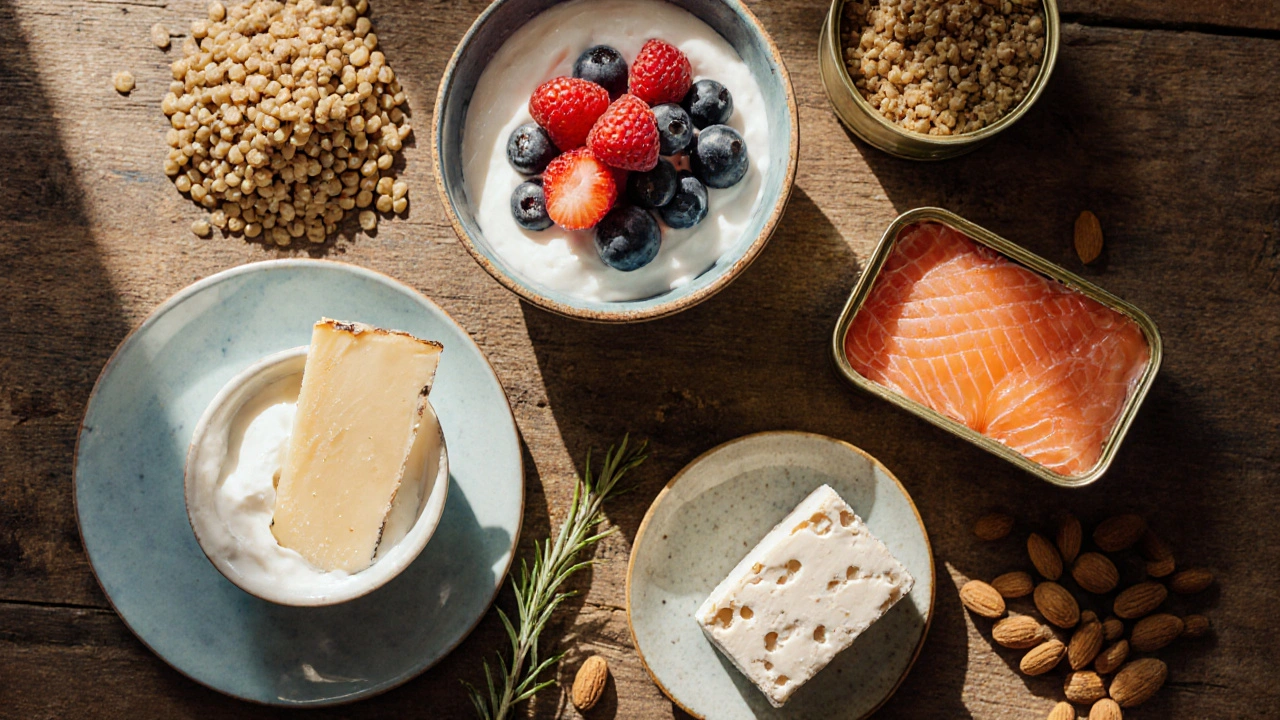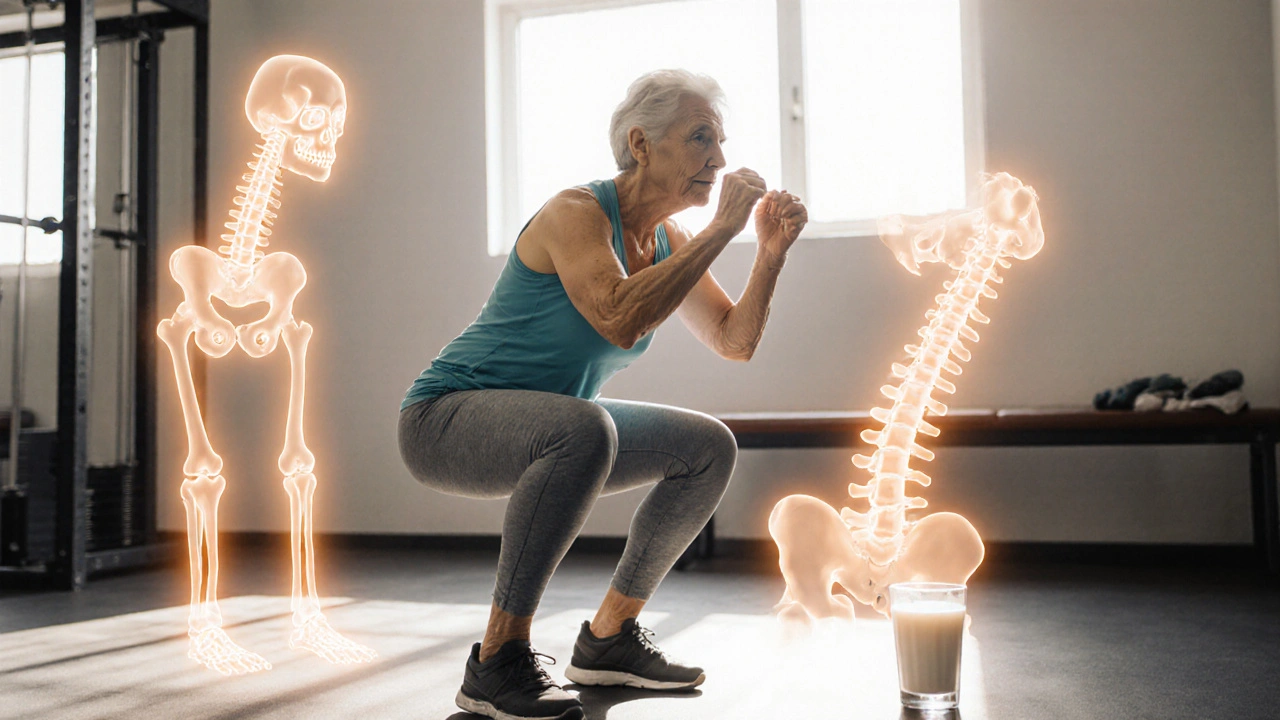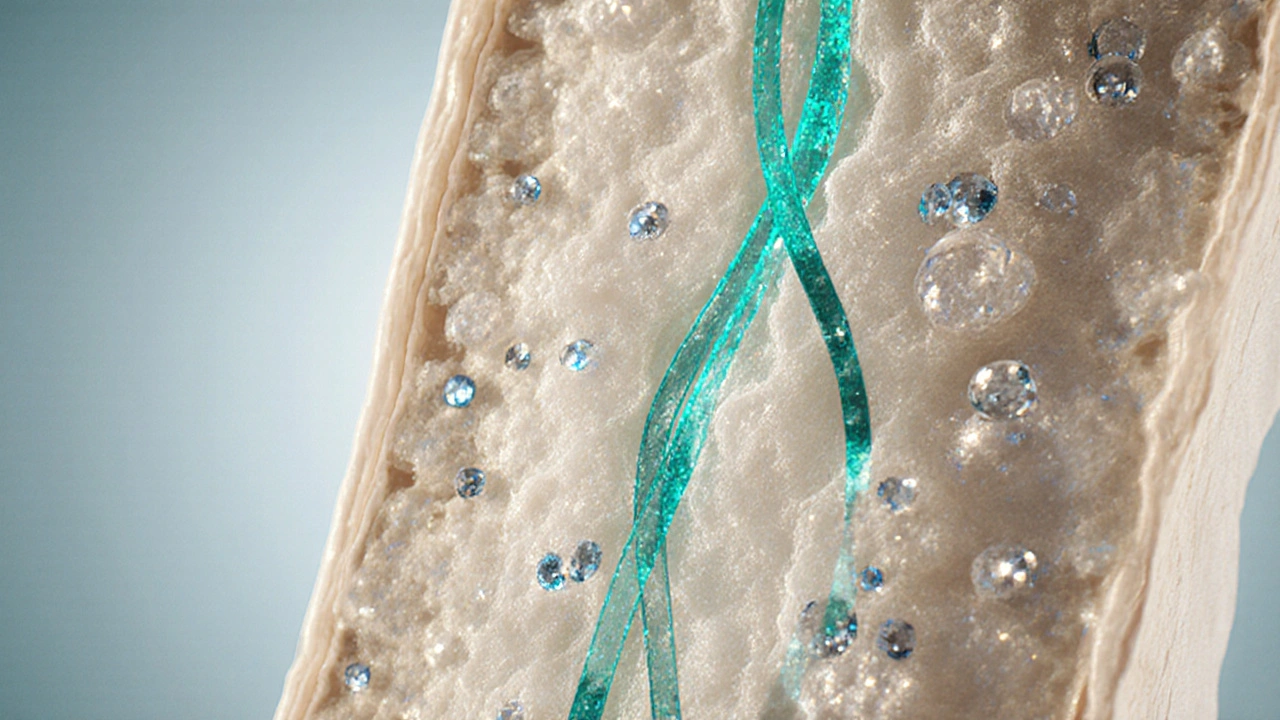Protein Intake Calculator for Bone Health
Your Recommended Daily Protein Intake
Enter your weight and select your age group and activity level to calculate your recommended protein intake for optimal bone health.
Quick Takeaways
- Protein provides the building blocks for bone matrix and supports bone remodeling.
- Adults should aim for 1.0-1.2g of protein per kilogram of body weight daily, more if active.
- Combining protein with calcium, vitaminD, and weight‑bearing exercise gives the best protection against osteoporosis.
- Both animal and plant proteins can be bone‑friendly; choose options rich in calcium and vitaminD.
- Avoid excessive low‑protein diets, especially in older adults, to reduce fracture risk.
Understanding Bone Health
Bone is a living tissue that constantly renews itself through a process called remodeling. Bone is a mineralized connective tissue composed mainly of collagen fibers and hydroxyapatite crystals provides support, protects organs, and stores calcium. Two cell types drive remodeling: osteoclasts, which break down old bone, and osteoblasts, which build new bone. The balance between these cells determines whether bone mass is maintained, lost, or gained.
When remodeling tips toward more resorption than formation, bone density declines-a condition known as osteoporosis is a skeletal disease marked by low bone mass and structural deterioration, increasing fracture risk. Age, hormonal changes, inadequate nutrition, and sedentary lifestyle are key drivers.
How Protein Influences Bone Remodeling
Protein’s role isn’t limited to muscles; it’s essential for the bone matrix too. Collagen makes up about 90% of the organic portion of bone, providing tensile strength is a protein fiber synthesized from specific amino acids, especially glycine, proline, and lysine. Without sufficient dietary protein, osteoblasts can’t produce enough collagen, leading to weaker bone structure.
Research from the Journal of Nutrition (2023) shows that higher protein intake correlates with increased bone mineral density (BMD) in both men and women over 50. The mechanism is twofold: 1) amino acids stimulate the production of insulin‑like growth factor‑1 (IGF‑1), which promotes osteoblast activity, and 2) adequate protein improves calcium absorption in the gut.
Getting enough protein also helps maintain lean muscle mass, which reduces the risk of falls-a common trigger for osteoporotic fractures.

Recommended Protein Intake for Bone Health
The general guideline for healthy adults is 0.8g/kg body weight per day, but recent consensus from the International Osteoporosis Foundation (2024) recommends 1.0-1.2g/kg for those over 40, and up to 1.5g/kg for athletes or individuals recovering from fractures.
For a 70kg (154lb) adult, that translates to 70-84g of protein daily. Splitting intake across meals (e.g., 20-30g per meal) ensures a steady supply of amino acids for bone turnover.
Special populations-post‑menopausal women, men on androgen‑deprivation therapy, and people with chronic kidney disease-should consult a dietitian, as their protein needs may differ.
Best Protein Sources for Bone Health
Not all proteins are created equal when it comes to supporting bone. Some also deliver calcium, vitaminD, and other micronutrients essential for mineralization.
| Source | Protein (g per 100g) | Calcium (mg) | VitaminD (IU) | Key Bone Benefit |
|---|---|---|---|---|
| Greek yogurt (low‑fat) | 10 | 110 | 40 | High calcium + probiotic support for calcium absorption |
| Cheddar cheese | 25 | 720 | 0 | Rich calcium, promotes bone matrix formation |
| Salmon (canned, with bone) | 22 | 200 | 450 | Omega‑3 fatty acids reduce bone loss, vitaminD aids calcium uptake |
| Chicken breast | 31 | 15 | 0 | Lean protein supports collagen synthesis |
| Foraged tofu (calcium‑set) | 8 | 350 | 0 | Plant protein with high calcium |
| Lentils (cooked) | 9 | 19 | 0 | Source of lysine and arginine for bone matrix |
| Almonds | 21 | 264 | 0 | Magnesium and calcium boost bone density |
Notice that dairy and fortified plant options deliver both protein and calcium, while fatty fish adds vitaminD, a combo especially powerful for bone preservation.
Lifestyle Strategies that Amplify Protein’s Benefits
Protein works best when paired with other bone‑protective habits.
- Calcium & VitaminD: Aim for 1,000‑1,200mg calcium and 800‑1,000IU vitaminD daily. Sun exposure (10‑15min midday) plus fortified foods help meet the target.
- Weight‑Bearing Exercise: Activities like walking, jogging, and resistance training stimulate osteoblasts. A study in Osteoporosis International (2022) found that participants who performed 150minutes of moderate resistance training plus adequate protein saw a 4% increase in femoral BMD over 12months.
- Avoid Excessive Sodium & Caffeine: High sodium increases urinary calcium loss; limit to <2,300mg/day. Moderate caffeine (<300mg) is fine but avoid heavy coffee consumption.
- Limit Alcohol: More than two drinks per day can impair bone formation.
Balancing these factors creates a synergistic environment where protein can fully contribute to stronger bones.

Common Myths About Protein and Bones
Myth 1: High‑protein diets leach calcium from bones. Early studies suggested this, but newer meta‑analyses (2021) show that when calcium intake is sufficient, higher protein actually improves calcium balance.
Myth 2: Only animal protein benefits bone. Plant proteins, especially soy, pea, and lentils, provide the necessary amino acids and, when calcium‑fortified, are equally effective.
Myth 3: You need massive protein shakes to protect bones. Whole foods supply a more balanced nutrient profile and are better for long‑term bone health.
Putting It All Together - A Sample Daily Plan
Below is a practical 2,200‑calorie menu delivering ~80g protein, 1,100mg calcium, and ~800IU vitaminD.
- Breakfast: Greek yogurt (150g) with berries and a tbsp of chia seeds - 15g protein, 150mg calcium.
- Mid‑morning snack: Almonds (30g) - 6g protein, 80mg calcium.
- Lunch: Grilled salmon (120g) with quinoa and steamed broccoli - 25g protein, 200mg calcium, 400IU vitaminD.
- Afternoon snack: Apple with 2tbsp peanut butter - 8g protein.
- Dinner: Stir‑fried tofu (150g, calcium‑set) with mixed vegetables and brown rice - 12g protein, 350mg calcium.
- Evening: Glass of fortified soy milk (250ml) - 7g protein, 300mg calcium, 120IU vitaminD.
Pair this plan with 30‑minute brisk walking and 2sessions of body‑weight resistance (squats, push‑ups) per week, and you’re covering the major pillars of osteoporosis prevention.
Frequently Asked Questions
Can I get enough bone‑friendly protein on a vegan diet?
Yes. Combine soy products, lentils, chickpeas, and calcium‑fortified plant milks. Aim for 1.0-1.2g/kg body weight and supplement vitaminD in winter months.
Is whey protein safe for older adults?
Whey is a high‑quality protein rich in leucine, which stimulates muscle and bone growth. For those with lactose intolerance, a lactose‑free isolate works just as well.
How much calcium should I consume if I increase protein?
Maintain the recommended 1,000‑1,200mg daily. Protein improves calcium absorption, but adequate calcium is still essential.
Does protein timing matter for bone health?
Distributing protein evenly (20‑30g per meal) keeps amino acid levels steady, supporting continuous collagen synthesis throughout the day.
Should I take protein supplements if I already eat a balanced diet?
Supplements are unnecessary if you meet the target from whole foods. They can be convenient for athletes or when appetite is low, but whole foods also provide calcium and vitaminD.
Take the Next Step
Start by tracking your daily protein intake for a week using a nutrition app. Compare the numbers to the 1.0-1.2g/kg recommendation for your age and activity level. Then, swap at least one meat‑based meal per day with a calcium‑rich plant alternative. Pair those changes with a 15‑minute walk or a simple resistance routine, and you’ll be on a solid path to stronger bones and fewer fractures.


HARI PRASATH PRASATH
October 10, 2025 AT 16:31Look, protein is teh real hero for bone health, not some fad diet.
Andrew Miller
October 12, 2025 AT 16:31I kinda feel like I’ve been ignoring my bones lately, and reading about protein made me realize I’ve been starving them. It’s weird how something as simple as a gram count can actually matter.
Brent Herr
October 14, 2025 AT 16:31Stop pretending you’re clueless – the science is crystal clear. If you’re not loading up on quality protein, you’re basically signing a contract with osteoporosis. Get your act together.
Julius Adebowale
October 16, 2025 AT 16:31Protein matters. Simple.
Daniel LaMontagne
October 18, 2025 AT 16:31Totally agree! 😊 Getting enough protein throughout the day really does keep those bones strong. Split it up – a little at each meal works wonders.
Jill Brock
October 20, 2025 AT 16:31Honestly, this whole “protein calculator” is just another hype train. People think they can outsmart their bodies with numbers while ignoring real nutrition. It’s infuriating!
Ellie Chung
October 22, 2025 AT 16:31Oh dear, the drama! While you toss the calculator aside, the ancient wisdom whispers: a balanced plate, rich in lean meats, beans, and dairy, sings a lullaby to your skeletal fortress.
Sophia Simone
October 24, 2025 AT 16:31While many revel in simplistic tools, a discerning reader must question the reductionist approach. Does a mere numeric output capture the nuanced interplay of amino acid profiles, hormonal regulation, and age‑related bone remodeling? I doubt it.
Juan Sarmiento
October 26, 2025 AT 16:31All right, team – think of protein like the crew on a construction site. If you don’t feed the workers, the building (your bones) won’t stay solid. Aim for 20‑30 g per meal and you’ll keep the scaffolding sturdy.
Patrick McVicker
October 28, 2025 AT 16:31Exactly! 🙌 Consistency is key – spread it out and watch the results.
Liliana Phera
October 30, 2025 AT 16:31When we contemplate the marrow’s silent plea, we realize that protein is not merely a macronutrient but a philosophical anchor, grounding us against the inexorable tide of decay.
Dean Briggs
November 1, 2025 AT 16:31Let us delve deeply into the intricate mechanisms by which dietary protein influences osteoblastic activity and the subsequent mineralization of the extracellular matrix, for it is through such understanding that we may appreciate the profound symbiosis between nutrition and skeletal integrity. First, amino acids derived from protein digestion serve as vital substrates for the synthesis of collagen, the primary organic component of bone, providing a scaffold upon which hydroxyapatite crystals can deposit. Second, the ingestion of sufficient protein stimulates the release of insulin‑like growth factor 1 (IGF‑1), a potent anabolic hormone that promotes osteoblast proliferation and differentiation. Third, protein intake modulates calcium absorption in the intestine, enhancing the pool of mineral available for bone formation. Moreover, research indicates that older adults who consume higher quantities of high‑quality protein experience a slower rate of bone loss compared to those with inadequate intake. This effect is especially pronounced when protein is coupled with resistance training, which further augments mechanical loading on the skeletal system. It is also noteworthy that the timing of protein consumption-distributed evenly across meals-optimizes the anabolic response, preventing the catabolic state that may arise from prolonged fasting periods. Conversely, chronic low‑protein diets have been linked to elevated cortisol levels, which can accelerate bone resorption. Additionally, the type of protein matters; dairy‑derived casein and whey have been shown to exert favorable effects on bone turnover markers relative to plant‑based sources, though the latter still contribute meaningfully when combined with adequate calcium and vitamin D. Finally, one must consider individual variability: genetics, hormonal status, and existing comorbidities all influence how effectively protein supports bone health. In summary, a holistic approach that includes adequate, high‑quality protein, regular weight‑bearing exercise, and optimal micronutrient status constitutes the most evidence‑based strategy for preserving bone density and preventing osteoporosis.
Sadie Speid
November 3, 2025 AT 16:31Boost that protein, boost that bone! 💪
Sue Ross
November 5, 2025 AT 16:31Interesting fact: studies show that consuming about 1.2 g of protein per kilogram of body weight daily can significantly improve bone mineral density in post‑menopausal women.
Rohinii Pradhan
November 7, 2025 AT 16:31While the empirical evidence you cite is not without merit, one must critique the over‑reliance on protein grams as a panacea. The interplay of micronutrients, hormonal milieu, and lifestyle factors cannot be reduced to a single macronutrient metric.
Anna-Lisa Hagley
November 9, 2025 AT 16:31Data suggests a positive correlation, yet correlation does not imply causation. The methodology of many studies leaves room for confounding variables.
A Walton Smith
November 11, 2025 AT 16:31Meh, whatever.
Theunis Oliphant
November 13, 2025 AT 16:31One must recognize the intellectual bankruptcy of reducing complex osteological health to a simplistic protein‑calculator. Such reductionism betrays a lack of scholarly rigor.
India Digerida Para Occidente
November 15, 2025 AT 16:31Respectfully, while I see your point about oversimplification, offering a practical tool can empower individuals to take actionable steps toward better bone health, provided they understand its limitations.
Andrew Stevenson
November 17, 2025 AT 16:31Bottom line: combine adequate protein with weight‑bearing exercise, vitamin D, and calcium, and you’ll give your skeleton the best odds against osteoporosis. Stay proactive!